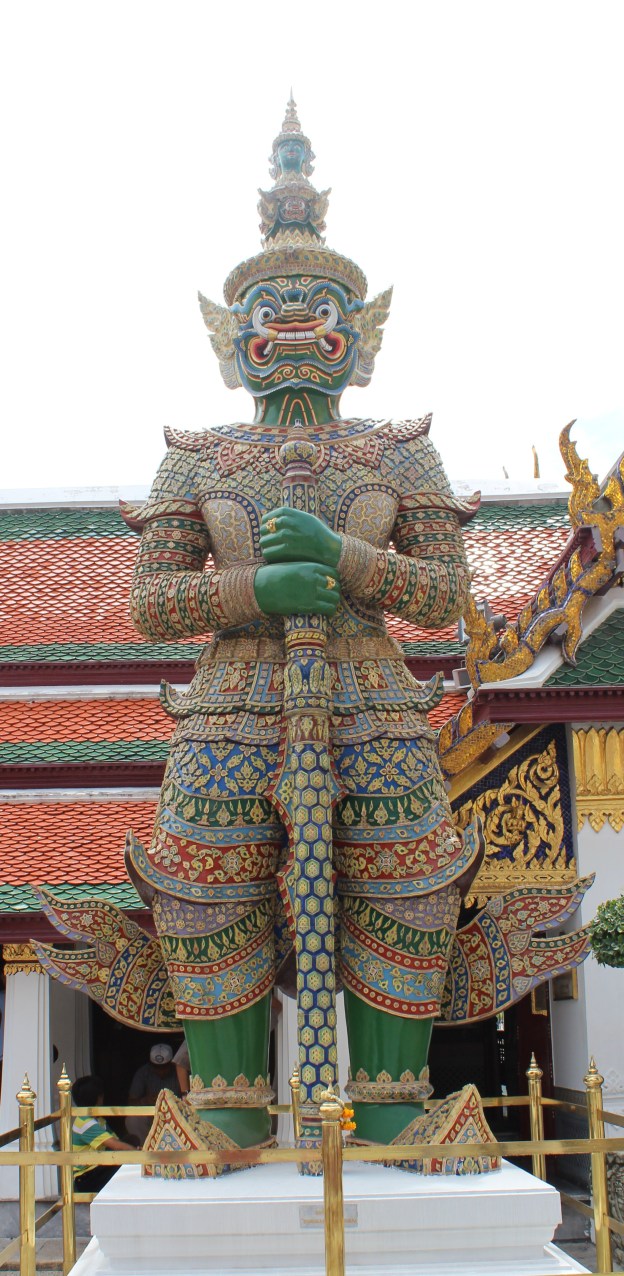So, we cross the road and enter into the Royal Palace.
The Royal Palace was the official residence if the Kings since 1782 and has been renovated often to preserve its grandeur. Though the Royal Family does not reside here, it is open for public view and is used for ceremonial purposes. Most of the buildings inside the Palace complex are closed to the public.
As we walk inside the long palace path, we come across three strikingly beautiful towers. These represent three different styles of temple architecture – Srilankan, Thai and Khmer. The golden stupa to the left representing19th century Srilankan, the middle pillared tower representing Thai and the right representing Khmer Architecture. The Srilankan Stupa is worshipped as the most sacred of all the three towers as Buddha’s relics – a piece of Buddha’s breast bone- are preserved here.
We are greeted by Yakshas – Demons guarding the Palace –
The intensely ornate Thai style architecture Library which contain sacred Buddhist manuscripts.
and the tranquil Buddha sitting in stone on the side of the library –
Ramakien
The Ramakien (รามเกียรติ์, “Glory of Rama”, sometimes also spelled Ramakien) is Thailand‘s national epic, derived from the Hindu epic Ramayana.
While the main story is identical to that of the Ramayana, many other aspects were transposed into a Thai context, such as the clothes, weapons, topography, and elements of nature, which are described as being Thai in style.
The Ramayana came to Southeast Asia by means of Tamil Indian traders and scholars who traded with the Khmer kingdoms (such as Funan and Angkor) and Srivijaya, with whom the Indians shared close economic and cultural ties. http://en.wikipedia.org/wiki/Ramakien
KambaRamayanam
In Tamil, Ramayanam is called ‘Kambaramayanam’ – Ramayanam written by Poet Kambar. Kambaramayanam occupies special place in the history of Tamil Literature for its distinct literary presentation and delivery of emotions through crisp language skills – by the ‘King of Poetry’ – Kavichakravarthy Kambar as he is hailed.
Kambar adopted Valmiki’s original Ramayana in the Tamil style, with changes made according to Tamil Culture. In other words, it is the re-telling of the story of Lord Rama without alienating from the Tamil lifestyle.
One of the situations is where Ravana the king abducts Sita from the hut where she is staying with Rama. In the Sanskrit version, Ravanaa lifts Sita and carries her. But this is unthinkable to the Tamilian. So Kambar makes a deviation and states that he lifted her up along with the hut and the earth below it and carried that piece of earth, hut and the lady in it. There are several such instances. http://en.wikipedia.org/wiki/Kambar_poet
Scenes of Ramakien, the Thai version of the Ramayanam decorates the walls in the Royal Palace Complex.
Is this Hanuman helping Rama’s force cross the sea to Lanka?
A stone model of Angkor Wat, Cambodia – the largest religious structure in the world, can be seen-
Kinnara and Kinnaree
Golden statues of Kinnara and Kinnaree greet the visitors –
In Southeast Asian mythology, Kinnaris, the female counterpart of Kinnaras, are depicted as half-bird, half-woman creatures. One of the many creatures that inhabit the mythical Himavanta. Kinnaris have the head, torso, and arms of a woman and the wings, tail and feet of a swan. She is renowned for her dance, song and poetry, and is a traditional symbol of feminine beauty, grace and accomplishment. http://en.wikipedia.org/wiki/Kinnara
This Kinnaree is an exclusive one – body of a female and legs and tail of a lion! Please do let me know if she is also a Kinnaree or has any other specific name in the mystical world.
and her counterpart – half male and half lion – our guide mentions he is also called Narasimha – the sanskrit word for man and lion.
And the exclusive Naga – Snake – with the head of an apsara – devine female and body of a snake… The usual Naga has the head of a demon and body of a snake – our guide tells us!
Wat Phra Kaew – The Temple of the Emerald Buddha
Wat Phra Kaew is considered the most sacred of the Buddhist temples in Thailand. The statue of Buddha is just over 2 feet tall and no photographs allowed from inside the temple room. Buddha is seated in a well crafted shrine, glittering in gold.
The Emarald Buddha is adorned with different costumes three time a year – summer, winter and the rainy months of the year. Only The King touches the statue and changes the costume of Buddha.
and the costumes for the three seasons –
Then we proceeded to the Grand Palace Grounds – the different Halls, added and renovated by successor Kings. Ancient Buddha stupas, Temples and Murals from literature, Ornate Temple Architecture in glittery gold – and a Palace Hall with a European touch – visit to Grand Palace has been an enthralling majestic experience. The shine of gold in bright sunny daylight and the master piece architectural beauty cannot surely be captured in one’s camera.
The efforts put to safeguard these important symbols of culture and literature – the endless renovation works being carried over are truly commendable. I would never miss another chance to visit again!














